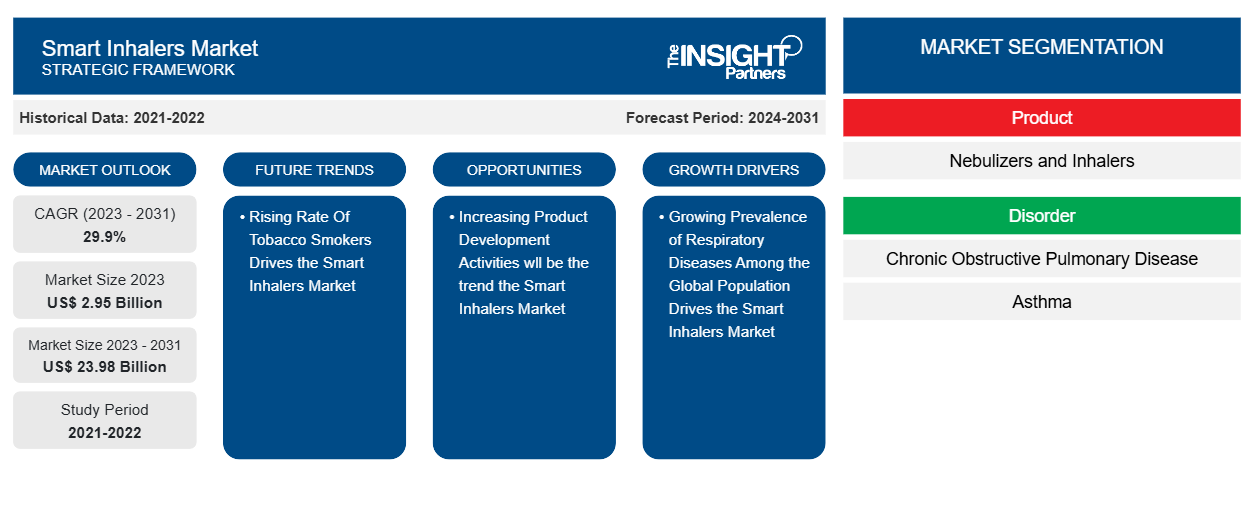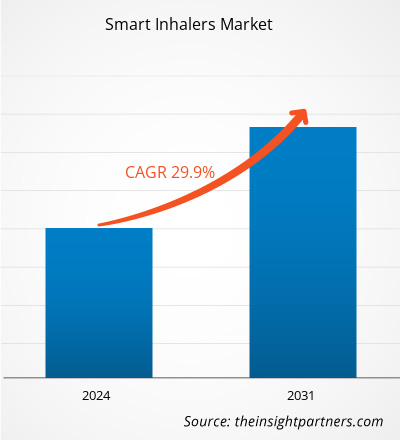The smart inhalers market size is projected to reach US$ 23.98 billion by 2031 from US$ 2.95 billion in 2023. The market is expected to register a CAGR of 29.9% during 2023–2031. Increasing acceptance of mobile health technology is likely to remain key trends in the market.
Smart Inhalers Market Analysis
The prevalence of asthma, chronic obstructive pulmonary disease (COPD), cystic fibrosis, and other respiratory diseases is increasing across the globe. For example, according to the World Health Organization (WHO), in 2022, the number of asthma-related deaths in 2019 was 455,000. In addition, the Burden of Disease Study in 2019 recorded 212.3 million cases of COPD worldwide, resulting in 3.3 million deaths. In addition, one of the major causes of respiratory diseases such as COPD and asthma is the rise in air pollution. Further, the Organization for Economic Co-operation and Development (OECD) estimates that global emissions of greenhouse gases are likely to grow by ~50% by 2050, primarily due to a 70% increase in CO2 emissions. Additionally, the beneficial effects on patients through combination therapy for asthma and COPD have increased, which has increased the demand for smart inhalers as they are one of the best ways to administer drugs. Hence, the growing prevalence of respiratory diseases among the global population is one of the factors driving the growth of the smart inhalers market.
Smart Inhalers Market Overview
Major factors driving the market growth includes rising cases of respiratory disorders, as well as growing adoption of generic inhalers. Additionally, increasing product development activities is likely to emerge as significant future trend in the market during the forecast period. However, lack of early diagnosis and high cost of inhalers is among the market deterrent factors.
Customize This Report To Suit Your Requirement
You will get customization on any report - free of charge - including parts of this report, or country-level analysis, Excel Data pack, as well as avail great offers and discounts for start-ups & universities
Smart Inhalers Market: Strategic Insights

-
Get Top Key Market Trends of this report.This FREE sample will include data analysis, ranging from market trends to estimates and forecasts.
Smart Inhalers Market Drivers and Opportunities
Rising Rate Of Tobacco Smokers to Favor Market
As per the Action on Smoking and Health (ASH) Fact Sheet, in the UK in 2022, 12.9% of adults are smokers, with 14.6% of men and 11.2% of women smoking. This equates to around 6.4 million people in the population. The adult smoking rates by country in the UK in 2022 were as follows: England: 12.7%, Wales: 14.1%, Scotland: 13.9%, and Northern Ireland: 14.0%. Rising rate of tobacco smokers is major drivers of global smart inhalers market share.
Increasing Product Development Activities
With new medical knowledge and effective medicines, treatment with a wide range of asthma inhalers continues to advance. Rising use of ventilator combination therapies and increasing investments by major players in developing sophisticated ventilator inhalers are boosting the demand for respiratory inhalers. In addition to the numerous advantages of the device such as portability, convenience, and effectiveness, the growing number of developments is expected to strengthen the demand for smart inhalers in the coming years. A few of the major developments and approvals are listed below:
- In May 2024, Teva launched a digitally-enabled inhaler in the UK, marking its debut in the European market. The inhaler is intended for use by patients with chronic obstructive pulmonary disorder (COPD) and asthma.
- In March 2024, Berry Global introduced the BerryHaler, a dual chamber dry powder inhaler (DPI) with a dose counter. This new inhaler is designed to improve patient access to and support the effective delivery of combination drugs.
Thus, such growing advancements by various market players and product approvals are likely to catalyze the growth of the global smart inhalers market during the forecast period.
Smart Inhalers Market Report Segmentation Analysis
Key segments that contributed to the derivation of the smart inhalers market analysis are product, , disorder, and end user.
- Based on product, the smart inhalers market is bifurcated into nebulizers and inhalers. The inhalers segment held a larger market share in 2023.
- By disorder, the market is bifurcated into asthma and chronic obstructive pulmonary disease. The asthma segment held the larger share of the market in 2023.
- In terms of end user, the market is bifurcated into home-care settings and hospitals & clinics. The home-care settings segment held a significant share of the market in 2023.
Smart Inhalers Market Share Analysis by Geography
The geographic scope of the smart inhalers market report is mainly divided into five regions: North America, Asia Pacific, Middle East & Africa, Europe, and South & Central America.
North America has dominated the market. The US held the largest share of the market in this region in 2023, followed by Canada, owing to the increasing prevalence of COPD and asthma among people in the region. According to an article published in Merck Sharp & Dohme (MSD) Manual, ~16 million people suffer from COPD, which is a leading cause of death, claiming over 150,000 lives annually in the US. Thus, growing chronic respiratory disorder in the US are driving the growth of respiratory inhalers market. Asia Pacific is anticipated to grow with the highest CAGR in the coming years.
Smart Inhalers Market Regional Insights
The regional trends and factors influencing the Smart Inhalers Market throughout the forecast period have been thoroughly explained by the analysts at The Insight Partners. This section also discusses Smart Inhalers Market segments and geography across North America, Europe, Asia Pacific, Middle East and Africa, and South and Central America.
Smart Inhalers Market Report Scope
| Report Attribute | Details |
|---|---|
| Market size in 2023 | US$ 2.95 Billion |
| Market Size by 2031 | US$ 23.98 Billion |
| Global CAGR (2023 - 2031) | 29.9% |
| Historical Data | 2021-2022 |
| Forecast period | 2024-2031 |
| Segments Covered |
By Product
|
| Regions and Countries Covered |
North America
|
| Market leaders and key company profiles |
|
Smart Inhalers Market Players Density: Understanding Its Impact on Business Dynamics
The Smart Inhalers Market is growing rapidly, driven by increasing end-user demand due to factors such as evolving consumer preferences, technological advancements, and greater awareness of the product's benefits. As demand rises, businesses are expanding their offerings, innovating to meet consumer needs, and capitalizing on emerging trends, which further fuels market growth.

- Get the Smart Inhalers Market top key players overview
Smart Inhalers Market News and Recent Developments
The smart inhalers market is evaluated by gathering qualitative and quantitative data post primary and secondary research, which includes important corporate publications, association data, and databases. A few of the developments in the smart inhalers market are listed below:
- In February 2022, Aptar Pharma, a global leader in drug delivery systems, services and active material science solutions, announced the launch of HeroTracker Sense, a novel digital respiratory health solution that transforms a standard metered dose inhaler (pMDI) into a smart connected healthcare device. (Source: Aptar Pharma, Press Release, February 2022)
- In October 2021, BreatheSuite announced that it received 510(k) clearance from the FDA for its Metered-Dose Inhaler V1 device, which turns existing inhalers into smart inhalers for people with asthma and COPD. (Source: BreatheSuite, Press Release, October 2021)
Smart Inhalers Market Report Coverage and Deliverables
The “Smart Inhalers Market Size and Forecast (2021–2031)” report provides a detailed analysis of the market covering below areas:
- Smart inhalers market size and forecast at global, regional, and country levels for all the key market segments covered under the scope
- Smart inhalers market trends as well as market dynamics such as drivers, restraints, and key opportunities
- Detailed PEST/Porter’s Five Forces and SWOT analysis
- Smart inhalers market analysis covering key market trends, global and regional framework, major players, regulations, and recent market developments
- Industry landscape and competition analysis covering market concentration, heat map analysis, prominent players, and recent developments for the smart inhalers market
- Detailed company profiles
Frequently Asked Questions
What is the expected CAGR of the smart inhalers market?
What would be the estimated value of the smart inhalers market by 2031?
What are the future trends of the smart inhalers market?
Which are the leading players operating in the smart inhalers market?
What are the driving factors impacting the smart inhalers market?
Which region dominated the smart inhalers market in 2023?
- Historical Analysis (2 Years), Base Year, Forecast (7 Years) with CAGR
- PEST and SWOT Analysis
- Market Size Value / Volume - Global, Regional, Country
- Industry and Competitive Landscape
- Excel Dataset
Recent Reports
Testimonials
Reason to Buy
- Informed Decision-Making
- Understanding Market Dynamics
- Competitive Analysis
- Identifying Emerging Markets
- Customer Insights
- Market Forecasts
- Risk Mitigation
- Boosting Operational Efficiency
- Strategic Planning
- Investment Justification
- Tracking Industry Innovations
- Aligning with Regulatory Trends





















 Get Free Sample For
Get Free Sample For